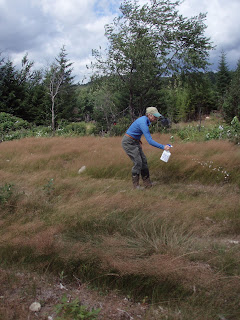
In this first photo, ash is being carried from the large pile of ash in the background
shadows.
Dave Borman evenly spreads the proportions through out the field. Don't ask me how he can get it so evenly covered!

A formula is determined how much ash needs to cover the soil to reach a ph of 6. This number is needed to grow the grains and legumes that are being seeded.

This week has been super busy getting Wagner's plots ready for seeding. Dave Borman, Club board member, and his trusty mascot, "The Kabota", spread the nine tons of ash over an acre. You can note from the photos how he finesses the ash as it falls out of his shovel! Thanks goes to the volunteers who assisted Dave: Reggie and Sheila Cyr, and Lyn Hewey with canine companion Corey. Rick Baker in his ATV, not seen here, dragged the spread ash so that it mixed in the ground. Now all we need is some rain!
 Reggie and Sheila Cyr sitting shotgun
Reggie and Sheila Cyr sitting shotgun

Lyn Hewey, Board Member and companion Corey.
 Reggie and Sheila Cyr sitting shotgun
Reggie and Sheila Cyr sitting shotgun
Lyn Hewey, Board Member and companion Corey.

















 Anvil Rock Plot was the first location to tackle. The day the ash arrived, a team of volunteers met to help Dave Borman spread the ash with his trusty Kabota. Although we had 9 volunteers, Dave expertly spread the ash without the help of manual raking.
Anvil Rock Plot was the first location to tackle. The day the ash arrived, a team of volunteers met to help Dave Borman spread the ash with his trusty Kabota. Although we had 9 volunteers, Dave expertly spread the ash without the help of manual raking.







